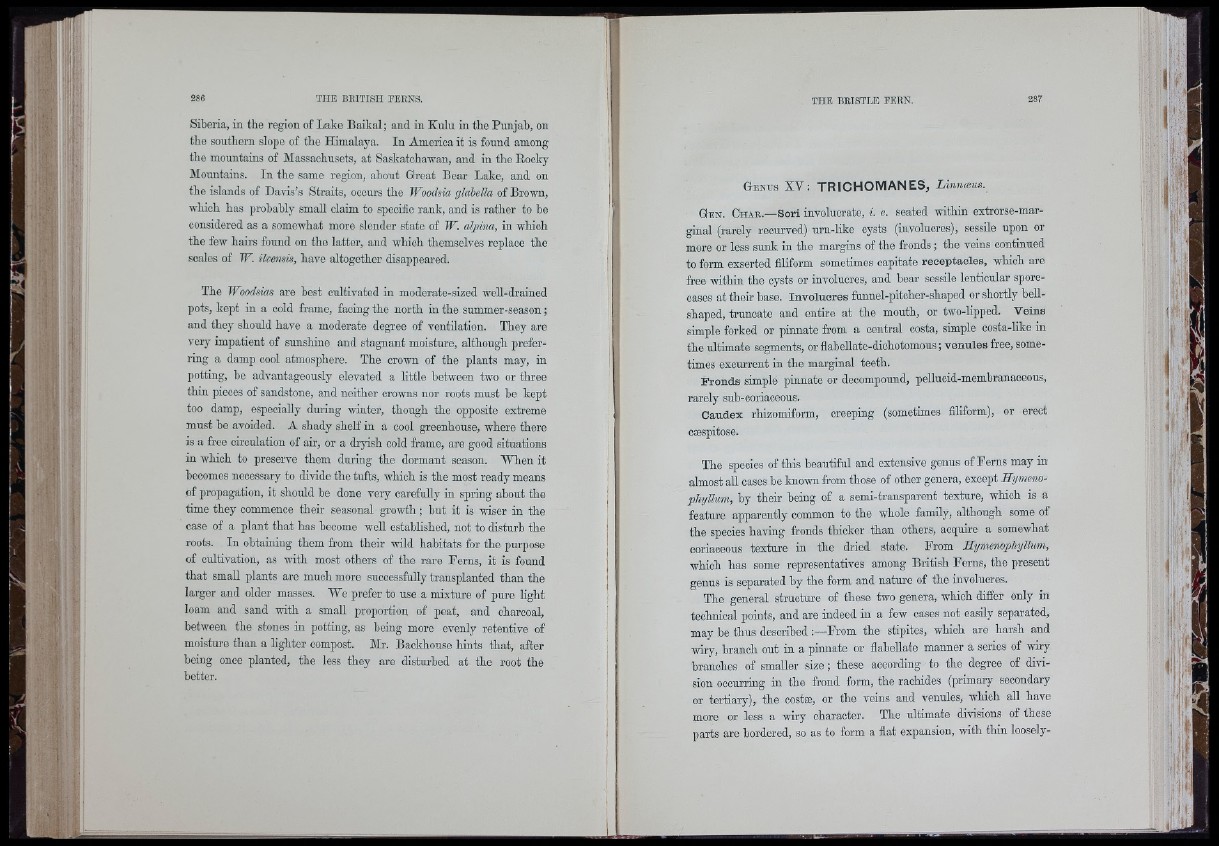
i ) ri
.4
J
Siberia, in the region of Lake Baikal; and in Kulu in the Punjab, on
the southern slope of the Himalaya. In America it is found among
the mountains of Massachusets, at Saskatohawan, and in the Eocky
Mountains. In the same region, about Great Bear Lake, and on
the islands of Davis’s Straits, occurs tho Woodsia glabella of Brown,
which has probably small claim to specific rank, and is rathor to he
considered as a somewhat more slender state of W. alpina, in which
tho few hairs found on the latter, and which themselves replace the
scales of W. ilvensis, have altogether disappeared.
The Woodsias are best cultivated in moderate-sized well-drained
pots, kept in a cold frame, facing the north in the summer-season;
and they should have a moderate degree of ventilation. They are
very impatient of sunshine and stagnant moisture, although preferring
a damp cool atmosphere. The crown of the plants may, in
potting, be advantageously elevated a little between two or three
thin pieces of sandstone, and neither crowns nor roots must be kept
too damp, especially during winter, though the opposite extreme
must he avoided. A shady shelf in a cool greenhouse, where there
is a free circulation of air, or a dryish cold frame, are good situations
in which to preserve them during the dormant season. When it
becomes necessary to divide the tufts, which is the most ready means
of propagation, it should he done very carefully in spring about the
time they commence their seasonal growth; but it is wiser in the
case of a plant that has become well established, not to disturb the
roots. In obtaining them from their wild habitats for the purpose
of cultivation, as with most others of the rare Ferns, it is found
that small plants are much more suooessfuUy transplanted than the
larger and older masses. We prefer to use a mixture of pure light
loam and sand with a smaU proportion of peat, and charcoal,
between the stones in potting, as being more evenly retentive of
moisture than a lighter compost. Mr. Backhouse hints that, after
being once planted, the less they are distui-bed at the root the
better.
Genus XV: T R I C H O M A N E S , Linnoeus.
Gen. Char.— Sori involúcrate, I e. seated within extrorse-mar-
ginal (rarely recurved) urn-like cysts (involucres), sessUe upon or
more or less sunk in the margins of the fronds ; the veins oontinued
to form exserted filiform sometimes capitate receptacles, which are
free within the cysts or involucres, and hear sessUe lenticular spore-
cases at their base. Involucres fuuuel-pitoher-shaped or .shortly beU-
shaped, truncate and entire at the mouth, or two-Upped. Veins
simple forked or pinnate from a central costa, simple costa-Uke in
the ultimate segments, or flabellate-diohotomous ; v enule s free, sometimes
exourrent in the marginal teeth.
Fronds simple pinnate or decompound, pelluoid-memhranaoeous,
rarely sub-coriaceous.
Caudex rhizomiform, creeping (sometimes filiform), or erect
oæspitose.
The species of this beautiful and extensive genus of Ferns may in
almost all oases he known from those of other genera, except Hymeno-
phyllum, by their being of a semi-transparent texture, which is a
feature apparently common to the whole famUy, although some of
the species having fronds thicker than others, acquire a somewhat
coriaceous texture in the dried state. From Hymenophyllum,
which has some representatives among British Ferns, the present
genus is separated hy the form and nature of the involucres.
The general structure of these two genera, which differ only in
technical points, and are indeed in a few oases not easily separated,
may be thus described :—From the stipites, which are harsh and
wiry, branch out in a pinnate or flabeUate manner a series of wiry
branches of smaller size ; these according to the degree of division
ooourring in the frond form, the rachides (primary secondary
or tertiary), the costæ, or the veins and venules, which all have
more or less a wiry character. The ultimate divisions of these
parts are bordered, so as to form a flat expansion, with thin loosely-
' Í
'U- . J.
Y '
■ rii'
■ii
t i l
k ‘;i
{ .,1’i
1 ‘
iill
Ifl
m
■yII